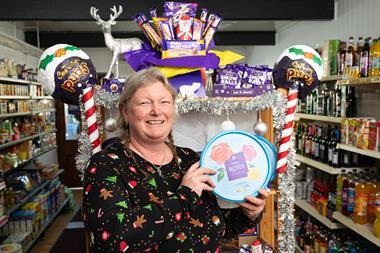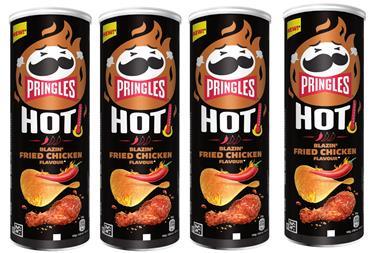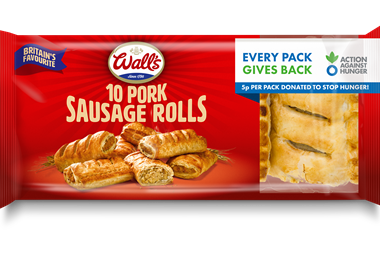January might be perceived as the month consumers recover from the excesses of Christmas and embark on new fitness regimes and healthier diets. But savvy retailers know all too well that, whatever the intentions, few shoppers can resist the little Easter treats that make their way onto shelves once the tinsel has been taken down.
Nestlé advises retailers to get their Easter treats out pronto. “With the Easter occasion in long-term value growth, up from £319m in 2011 to £340m in 2015, it continues to be a significant sales opportunity for retailers,” said shopper marketing manager Rosamunde Hobson. “In 2015 8.3 million households bought in the early season, with 80% of shoppers buying again. The early season, therefore, is important for retailers and those looking to maximise sales should ensure they stock up on Easter impulse lines as soon as the Christmas season is over.”
The firm claims that seasonal impulse products offer retailers an incremental sales opportunity on top of existing singles confectionery sales. It is a popular area of Easter confectionery, worth £122m.
Returning to the Nestlé range in 2016 are Smarties Little Choc Chick, the number three impulse novelty in the market, and Milkybar Bunny, which is now the number four impulse novelty, according to the company.
The Aero Bubbly Egg, which launched last Easter, is also back in the range for 2016 with a packaging refresh. A huge 86% of shoppers were new to the Bubbly brand and in particular it drew in a lucrative audience of older shoppers, claims Hobson.
Rosamunde Hobson added: “Some 70% of Easter confectionery sales are from immediate-consumption products, which over-index in the early season.
“The seasonal impulse category provides an incremental sales opportunity for retailers. Success will result from focusing on the right range at the right time, exploiting the full length of the season.”
Mondelez International agrees that Easter treats must be on shelf in January in order to make the most of the season. Trade communications manager Susan Nash said: “Every day you don’t have your display up is a day of missed sales. Easter is still ending on March 27.”
This year the firm is launching a Cadbury Dairy Milk (CDM) Vanilla Mousse Bunny into the seasonal treat category, following the previous success of the CDM Mousse Snowman, which it claims was the number-one self-eat in Christmas 2014, but the big story for Cadbury remains the Cadbury Creme Egg. Currently worth £9.7m, the firm states that the brand put in a “solid performance” in 2015.
Cadbury Creme Egg & Mini Egg brand manager Laura Mimoun said: “It drove three times more value over the nearest competitor.”
Cadbury brand manager for Easter Jan Trichterborn added: “Even more spectacular than seasonal chocolate incremental sales is Cadbury Creme Egg incremental sales. The biggest spike is at the beginning of the season. In 2016, we are bringing back single products targeting teens and young adults, six-packs targeting adults, and 12-packs for Easter sharing.”
This season the company is investing £4m in Creme Egg (that’s £1m more than last year) from January to March. This will comprise TV, digital, PR, in-store and outdoor marketing activity, including the return of the Gooless campaign.
From 1 January a third-party organisation will visit c-stores and when they see Gooless POS they will plant a Gooless egg, which is the same weight and size as a standard egg, and leave without telling staff. Consumers who find it - and the retailer that sold it - will be awarded either £100 or £1,000, and the store will also receive a certificate to display in store.
In addition, Mondelez is running a shelfie competition for retailers over January and February, in which the store owner or manager can take a photo of their Gooless display and send it to Mondelez’s Delicious Displays website to be in with a chance of winning £250-worth of Love to Shop vouchers.
“Some 78% of the country saw the Cadbury Creme Egg campaign last year,” says Mimoun. “It’s all about having a fast start for Cadbury Creme Egg. The convenience channel is worth half of Cadbury Creme Egg sales in the first week of the season.”
Ferrero urges retailers to make room for Kinder Joy
Mums will have another option with which to treat kids in the run-up to Easter: Kinder Joy from Ferrero. The limited-edition plastic egg features a tab opening up into two halves - one half to discover layers of milk and cocoa cream, and one half to reveal a toy, along with a spoon.
Kinder Joy (rrp 99p) is being added as a seasonal sub-brand to the Kinder portfolio, worth £98m.
“We tested Kinder Joy last Easter in Ireland,” says customer development director Levi Boorer. “We were a bit concerned about whether it would affect Kinder Surprise sales as it looks like a chocolate egg, but it held its own.”
He claims that 61% of sales were incremental to Kinder Joy. “We don’t believe that there is a big risk of cannibalisation with Kinder Surprise,” says Boorer. “Kinder Joy uses similar ingredients to Bueno, but it is more of a limited-edition, indulgent, portable product.”
The company claims that Kinder Joy offers a potential £3.6m incremental sales opportunity. “As you would expect with our biggest launch of the year we will be supporting it with a heavyweight marketing campaign designed to capture the imagination of mums,” says Boorer. “We anticipate that this launch will replicate the success of Kinder Joy in Ireland where 40% of buyers were new to Kinder Surprise and 8% were incremental to the entire Easter confectionery category. The results in Ireland give us real confidence that Kinder Joy will be a huge success in the UK as the consumers have very similar purchasing habits.”
Mars Chocolate UK is also urging retailers to get Easter treats on-shelf earlier. The Malteaster Bunny is the number two Easter treat product, claims the firm.
Trade relations manager Bep Dhaliwal said: “Getting Malteaster on shelf from Boxing Day is critical for retailers to benefit from the self-eat part of the season.
“As long as you execute self-eat early, Easter can be a success. It’s about making the most of the season.”
Saki Ghafoor, who owns two Nisa stores in Northumberland and Tyne & Wear, already has Creme Eggs out on shelf. “We had conversations with Cadbury about Creme Eggs back in October,” he said, “We’ve had them out since the end of November. They generally do well over Christmas. Everyone has a bit of a moan that it’s too early, but they’ll still buy them because they’re only here once a year.”
He has also seen success with other seasonal treat items. “The Malteaster Bunnies do well. They have a certain group of consumers who are loyal to the brand. We don’t have them out as early as Creme Eggs, but we’ll start selling them from January or February. We put them on countertops or in dumpbins.”
Cadbury Creme Eggs are on shelf before Christmas at Nisa Welwyn Garden City, Hertfordshire, too, along with Cadbury Mini Eggs. “Customers don’t mind them being in-store early,” says owner Peter Singh Dhesi. “People actually look for them at that time of year now. I had customers coming in early November asking if we had Creme Eggs in stock yet.”
He sells treat eggs on promotion to capture consumers’ attention. “We’ll sell Creme Eggs and Cadbury Caramel Eggs at three for £1.20 or £1, depending on what deal we get.”
Strong product positioning is key to sales, he notes. “Mini Eggs are positioned around the store. I have four stands coming from Cadbury,” said Peter. “We’ll have one out at Christmas and the rest in the new year. We also stock Aero Eggs and the Smarties Chick, Galaxy Eggs and Lindt Bunnies. With the novelty items and eggs we put them at the checkout in a dumpbin and on the counter.
“The Malteaster Bunny does well. It’s an impulse purchase - no one comes in to buy them, but if they see them then they’ll pick them up, so we put them on the counter to catch people’s eye.”
Spar Bodicote, Oxfordshire, also leads with Creme Eggs, swiftly followed by Malteaster Bunnies. “The Creme Eggs go out as soon as they arrive, which is usually Boxing Day,” said owner Sally Read. She then gets her other Easter treat and sharing items in-store in January. “Malteaster Bunnies also sell really well,” she adds.
Charles Brady of Vic’s Stores in Nettlestone on the Isle of Wight has his Cadbury Creme Eggs out in January. “We pre-ordered 10 Cadbury Creme Egg cases and got one free back in September, and we’ll offer them on a special price. Last year we sold them at three for the price of two.”
He claims that his store isn’t big enough for a full display, but he makes it a priority to find space for them on-shelf. “Our aisles aren’t wide enough for hods, but we use our epos system to find the worst-selling items and we make room for treat eggs. Consumers have had all the usual confectionery over Christmas and they want something different.”
Ian Mitchell, who owns three Premier Stores in Ayrshire, is eagerly awaiting his Creme Eggs delivery. “I spoke to my Cabury rep at the end of October and Creme Eggs will be coming to us after December. Because it’s not on shelves for six months it’s like a new product from the consumers’ perspective. They fly out the door. I sell box upon box - about five a week from new year until Easter.”
He ensures he gives them a strong position in-store. “We’ll dual-site Creme Eggs on the counter and by the kids’ sweets. When a product is on the counter, it usually sells itself.” By the end of January, he has seasonal sharing bags and a dedicated display for treat products. “We have an Easter display with Creme Egg, Cadbury Caramel Eggs, Malteaster Bunnies and so on. They seem to sell better when they are more visible. We usually have Malteaster Bunnies on promotion with Premier in February.”
Trends
Something for the grown-ups
Sales of mini eggs grew 2.2% in 2015 and are now worth £57m, according to Nestlé.
“The majority of mini eggs packs are designed to appeal to shoppers with children, however 67% of mini eggs shoppers do not have children,” points out Nestlé shopper marketing manager Rosamunde Hobson. The company claims that there is a huge opportunity for a more grown-up offering. “Dark chocolate is bought by 65% of households in the UK and sales of dark chocolate Easter eggs grew 13% in 2015,” adds Hobson. “Black Magic, the UK’s number one dark boxed chocolate, aims to tap into this popularity with a more premium mini eggs offering, aiming to appeal to an older, more upmarket demographic.”
Black Magic Mini Eggs retail at £2.
Meanwhile, Smarties Mini Eggs and Milkybar Mini Eggs both grew ahead of the market, up 17% and 13% respectively, benefiting from a motivating £1 price point, states Nestlé. Both packs will return to the range this Easter.
Drive impulse
Lindt & Sprungli concurs that retailers need to give treat products a prominent position in-store. “To maximise Easter early season sales opportunities, place filled eggs, mini eggs, treating and novelties close to till points to drive impulse purchases,” says customer marketing representative Gemma Blake.
In addition to their existing offerings, another area that retailers may wish to explore is premium seasonal treats, she advises. “Filled eggs are an important indicator of the Easter season within the convenience store formats. Last year premium grew at 30.3% driven by Lindt [IRI 4/12/15/17 weeks 19 April 2014 and 4 April 2015].”
She states that premium products also drove growth within Easter novelties. “Easter novelties grew at 3.8% in value last Easter, with growth driven by premium, up 13.1%. Premium over-indexes significantly in novelties versus all Easter segments (premium share of novelties is of 36.8% vs premium share of Easter total of 10.1%).”
Lindt claims to have a 20% value share of Easter novelties within convenience, and is growing at 11.3% year on year.
Lindt Lindor 28g is the number one premium filled egg, growing at 39% year on year, and valued at £264,000, says the company. It adds that Lindt Gold Bunny is the number one hollow figures brand in convenience. “Lindt Gold Bunny 100g, the biggest Lindt Gold Bunny SKU, is the biggest premium novelty in convenience; it represents £730,000 and is growing 6.9% year on year (up £47,000),” says Blake.
Lindt & Sprungli agrees with other industry experts that getting seasonal treat products on shelf at the very beginning of the season is vital to make the most of Easter. “Easter 2016 will be the shortest season since 2008 with only a 12-week window,” says Blake. “Making a fast start and driving impulse purchase from the off will be key. It is vital that retailers start to excite and engage shoppers from the start of the year with filled eggs, mini eggs, treating and novelties.”
Cadbury’s Trichterborn agrees: “A lot of retailers do a great job of it, but others miss out. If you get it right, it doesn’t matter that the season is short. You can still be very successful.”
Oreo at easter
Following the successful countline and tablet products, Cadbury Dairy Milk Oreo will be joining Cadbury Creme Egg, Cadbury Dairy Milk and Cadbury Dairy Milk Daim in Mondelez International’s mini wrapped egg range. The line-up saw 32% growth in 2015.
Source
Sarah Britton




























No comments yet